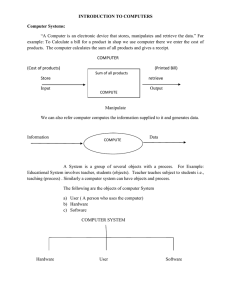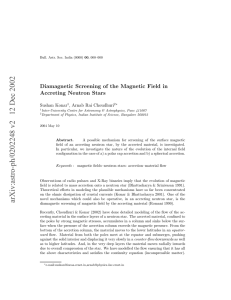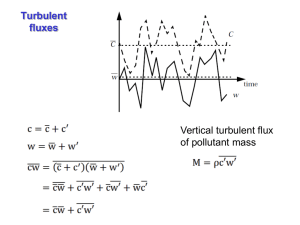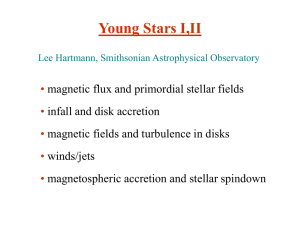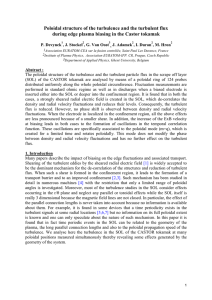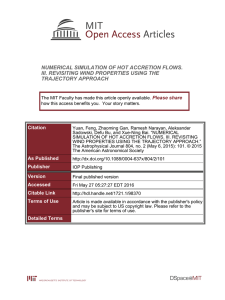The Accretion of Poloidal Flux by Accretion Disks
advertisement
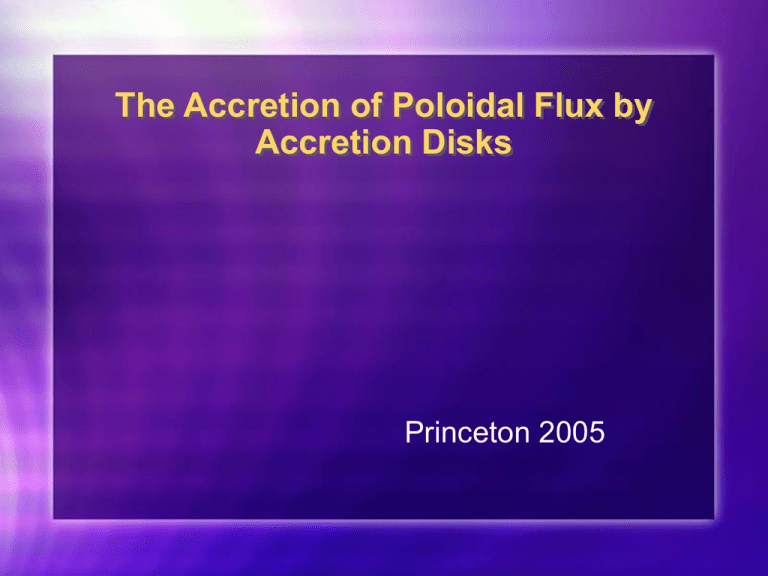
The Accretion of Poloidal Flux by Accretion Disks Princeton 2005 What is an Accretion Disk? Original theoretical description by Shakura and Sunyaev Flattened, rotationally supported, gas accreting onto a central object over the course of many rotation periods. A good fluid, i.e. a high collision rate and a short mean free path. Negligible gravity due to disk. (ignoring galaxies, outer parts of AGN disks) Not necessarily ionized, but here we will discuss only good conductors. (ignoring intermediate radii in protostellar disks) Fundamental Questions About Disks 1. Are accretion disks turbulent? Yes - the Magnetorotational Instability (MRI) 2. How is angular momentum transported outward? Internal stresses? Stress transmitted through an external field? 3. Does the environment play a role? Is accreted magnetic flux important? How is magnetic flux accreted? The usual assumption is that entrained flux moves with the accreting plasma. This process is balanced by the outward turbulent diffusion of bent magnetic field lines. This gives (van Ballegooijen) cs H r : Br B DT H : cs Br B z z In other words, the field lines bend very slightly as they pass through a narrow disk, which limits the accretion of external flux to a negligible level. The use of turbulent diffusion is rather controversial. Magnetic Helicity and Turbulent Diffusion The electromotive force in a turbulent medium, has a piece of the form: r DT J, DT : v2 eddy 3 When the turbulence is anisotropic due to shearing, the diffusion coefficients differ and attach to the appropriate gradient. When the back reaction is large, the diffusion is suppressed by the factor . The radialI diffusion of entrained flux is b̂b̂ suppressed by the ratio of the perpendicular B 2 components to the total field. 2 B Outward diffusion = inward drag when…. Balancing inward drag and outward diffusion, as before, we get a critical poloidal field strength 1/2 1/2 H & Bcrit : B : M r r This is just big enough that the radial and vertical field components will be similar (Lubow, Papaloizou and Pringle 1994) and the stress (and angular momentum transport) through the magnetosphere will be comparable to the internal transport. When the poloidal field is weaker than this, it will be dragged inward. Due to this, and the scaling of disk properties, the poloidal field will typically affect the innermost part of the accretion disk, or none of it. When it does, it can drive a Blandford-Payne jet. When does the environment supply enough magnetic flux? Since the accreted poloidal field has nowhere to go, whether or not one gets an inner annulus dominated by a large scale poloidal field will depend on the environment. In general, it’s not obvious what this means for systems that accrete from the ISM. We can look at binary accreting systems, and assume that the accretion disk can accrete some fraction of the donor star’s poloidal field, determined by the size of the disk. This will be important if Bp rdisk 2 rinner Bcrit M r Plugging in Numbers…. Obviously, for otherwise identical accreting systems, this is more likely to give us a strong poloidal field when the accreting object is a compact object, the smaller the better. A white dwarf near the Chandrasekhar limit, accreting at 10^18 gm/sec, with an externally imposed field of about a gauss, and an inner disk radius of ~3x10^10 cm, will fail to acquire a strong poloidal field by a bit more than an order of magnitude. In the same kind of system a black hole will easily acquire a strong poloidal field. Jets? Conclusions (&speculations) The suppression of turbulent diffusion by magnetic helicity conservation implies that available flux is strongly concentrated at small radii The accretion of a large scale field from the environment can produce an organizing field for a jet. This may explain the systematic difference between accreting white dwarfs and black holes. Since the critical magnetic field strength increases with the accretion rate, systems with fluctuating mass accretion rates are more likely to have magnetically dominated inner regions during low states, and show a transient burst during the transition to the high state.

